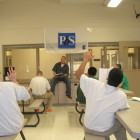
Delinquent by Reason of Poverty
|
With the publication of Michelle Alexander’s provocative book, "The New Jim Crow: Mass Incarceration in the Age of Colorblindness," our attention has been drawn to the troubling reality that the majority of young African-American men living in our cities are either incarcerated or on probation or parole. As a result of the ill-conceived “War on Drugs,” our communities of color have been decimated, and a vast population has been left unemployable and disenfranchised. Professor Alexander powerfully demonstrates that America’s racial caste system did not end with the outlawing of state-sanctioned segregation but merely reconstituted itself. With the demise of Jim Crow, the criminal justice system now functions as our society’s system of racial control. Yet, there is an important piece of this picture that has been overlooked.







